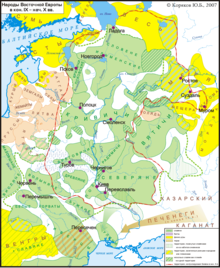Krivichs
This articleneeds additional citations forverification.(December 2017) |


TheKrivichsorKryvichs(Russian:кри́вичи,romanized:krivichi,IPA:[ˈkrʲivʲɪtɕɪ];Belarusian:крывічы́,romanized:kryvičý,IPA:[krɨvʲiˈt͡ʂɨ]) were a tribal union ofEarly East Slavsbetween the 6th and the 12th centuries.[1]It is suggested that originally the Krivichi were native to the area aroundPskov.[2]They migrated to the mostlyFinnicareas in the upper reaches of theVolga,Dnieper,Dvina,areas south of the lower reaches of riverVelikayaand parts of theNemanbasin.[3]
In some variants of Belarusiphileanti-normanisthistory, the city, and later principality ofPolotskis linked to Krivichians, much like Kyiv is linked toPolianians,however, based on most modern evidence, these were all likely linked toRus' people.[4]
Etymology[edit]
Many historians suggest that the name of the tribe probably stems from that of their legendary forefather Kriv, possibly akniazor avoivode.According toMax Vasmer,thissobriquetwas derived from the Slavic adjectivekrivoy( "crooked/twisted" ) due to some possible birth defect.Jan Stankievičbelieved it was derived from the adjectivekroŭ/kryvi( "blood" ), hence,kryvičwould mean "blood relationship".
History[edit]
The Krivichs left many archaeological monuments, such as the remnants of agricultural settlements with traces of ironworks, jeweler's art, blacksmith's work and other handicrafts; long burial mounds of the 6th to 9th centuries with cremated bodies; burial mounds of rich warriors with weapons; sets of distinctive jewelry (bracelet-like temporal rings and glass beads made out of stretched wire). By the end of the first millennium, the Krivichs had already had well-developed farming and cattle-breeding. Having settled around theTrade route from the Varangians to the Greeks,the Krivichs traded with theVarangians.Their chief tribal centres wereGnezdovo,Izborsk,andPolotsk.
The Krivichs as a tribe took part inOleg's andIgor's military campaigns against the Byzantine Empire. They are also mentioned inDe Administrando ImperioasKrivitzoí(Κριβιτζοί).
Modern uses of the name[edit]
- Today, inLatvian,Krievsmeans "Russian" andKrievijais "Russia". Through Baltic territories, the word became known in Central Europe. For example, a German chronicler fromDuisburgwrote in 1314: "Frater Henricus Marschalcus... venit ad terramCrivitae,et civitatem illam, quae parva Nogardia dicitur cepit".And in a Polish publicationKazanie na Pogrzeb Maryanny Korsakywnej(Lublin,1687. Б. II, 49) thePolotsksaint Paraxedis was calledRegina Krivitae(the queen of the Kryvians).
- Also in Latvian, a Belarusian is known asBaltkrievs,and Belarus is namedBaltkrievija.The prefixbalt-is from the Latvian wordbaltswhich means "white", thusBaltkrievijais cognate to "White Russia"and" Belarus "itself.
- Kryvich(Крывіч) was the name of a magazine that the Belarusian historianVaclau Lastouskipublished inKaunasfrom 1923 to 1927.
- Kriwiis the name of a Belarusian folk-rock band.
- Places namedKryvičyin modern Belarus are possibly named after the tribe, however this is contested basing on the suggested areal of Krivichs.[5]
See also[edit]
References[edit]
- ^Olson, James Stuart; Pappas, Lee Brigance; Pappas, Nicholas Charles (1994).An Ethnohistorical Dictionary of the Russian and Soviet Empires.Greenwood Publishing Group. p. 88.ISBN9780313274978.
- ^"Становление культуры псковских длинных курганов".
- ^Živković, Tibor; Crnčević, Dejan; Bulić, Dejan; Petrović, Vladeta; Cvijanović, Irena; Radovanović, Bojana (2013-07-01).The World of the Slavs: Studies of the East, West and South Slavs: Civitas, Oppidas, Villas and Archeological Evidence (7th to 11th Centuries AD).Istorijski institut. p. 327.ISBN9788677431044.
- ^Nation-building in the post-Soviet borderlands: the politics of national identities.Graham Smith. Cambridge [England]: Cambridge University Press. 1998. p. 32.ISBN0-521-59045-0.OCLC37755070.
{{cite book}}:CS1 maint: others (link) - ^Ежы Ахманскі. Літоўская этнічная мяжа на ўсходзе ад племянной эпохі да XVI стагоддзя // ARCHE 2 2016. С. 13—96.
